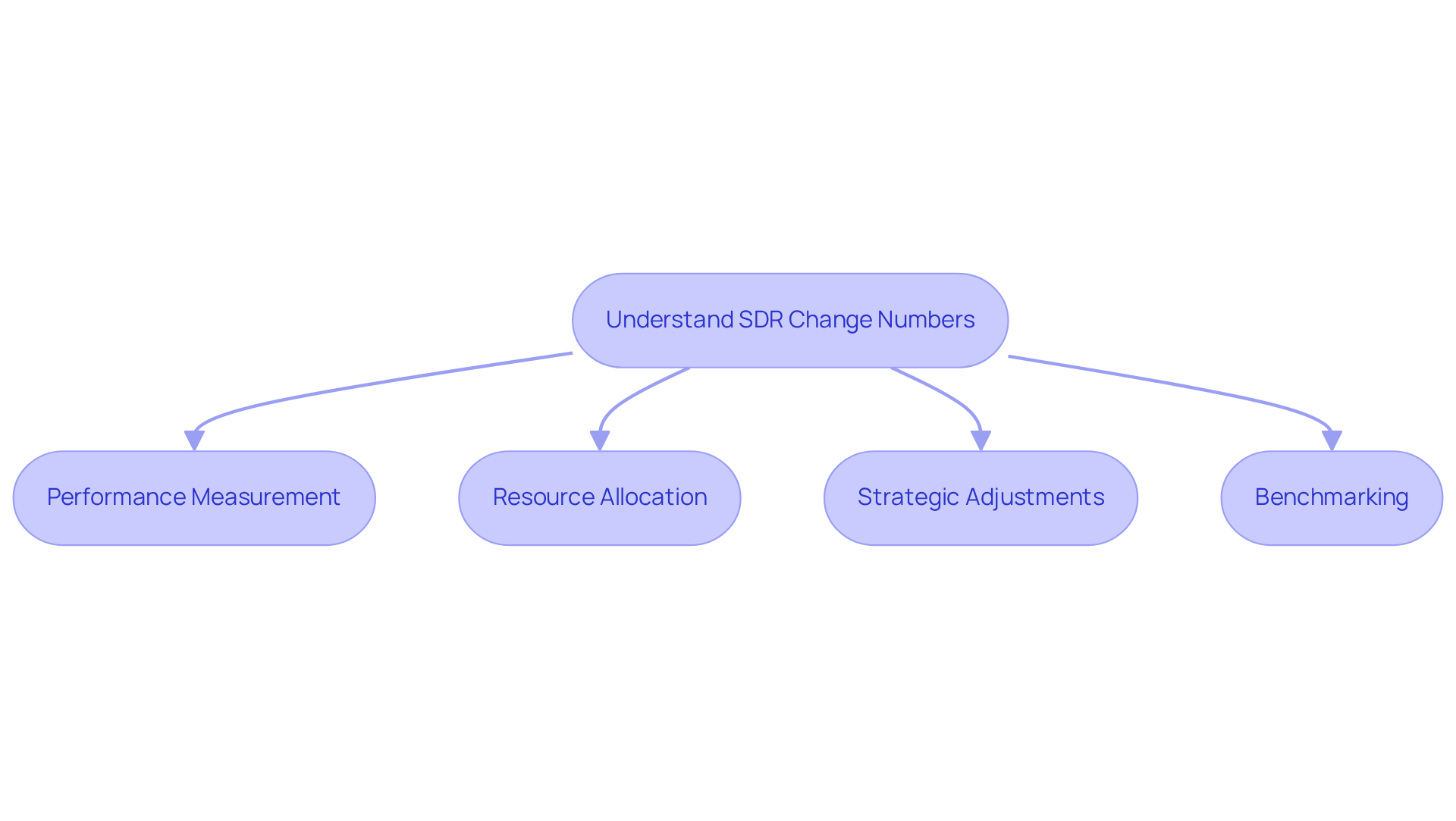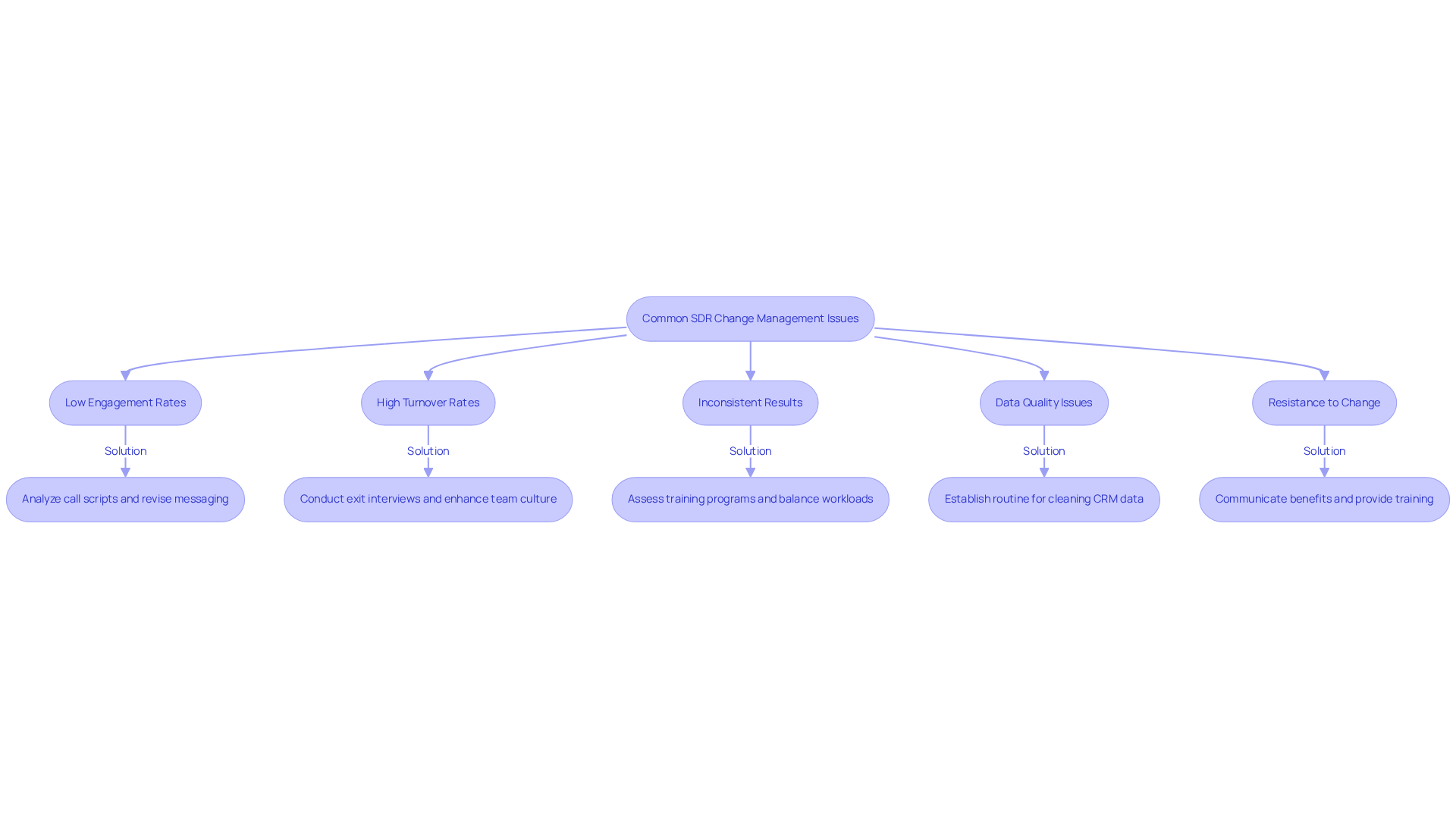Overview
The article highlights essential strategies for sales managers in finance to effectively oversee SDR change numbers, which serve as critical metrics for evaluating the performance of sales development representatives. By understanding these metrics, managers can:
- Enhance performance measurement
- Allocate resources more efficiently
- Make informed strategic adjustments
Furthermore, the integration of tools like AI voice agents, which provide real-time analytics and feedback, is crucial in driving improved sales outcomes. This approach not only enhances operational efficiency but also fosters a data-driven culture that empowers sales teams to excel.
Introduction
Understanding the intricate dynamics of sales development representatives (SDRs) is crucial for any sales manager aiming to elevate their team's performance. SDR change numbers serve as essential metrics that not only gauge individual effectiveness but also drive strategic decisions that can significantly impact revenue generation. However, with the pressures of fluctuating market demands and the need for continuous improvement, how can managers effectively harness these metrics to foster a high-performing sales environment? This article delves into actionable strategies and tools that can empower finance sales managers to master SDR change numbers, ultimately leading to improved sales outcomes and enhanced team efficiency.
Understand SDR Change Numbers and Their Importance
SDR change numbers encompass the metrics that track the performance and activities of sales development representatives, playing a crucial role in sales strategy for several reasons:
-
Performance Measurement: These metrics are essential for evaluating how effectively sales development representatives generate leads and convert them into sales opportunities. Teams that concentrate on key efficiency indicators (KPIs) such as conversion rates and meeting booked rates often observe a direct correlation with increased revenue. Significantly, SDRs account for between 30% and 45% of their company's overall revenue, highlighting their importance in evaluation. With Intone's AI voice agents, including features like voice cloning from top-performing agents, teams can utilize real-time analytics to monitor these metrics closely, permitting prompt adjustments that improve performance.
-
Resource Allocation: By understanding these metrics, sales managers can allocate resources more effectively. High-performing sales development representatives, identified through metrics like pipeline contribution and response rates, can receive additional support and training, maximizing their potential. Intone's AI capabilities facilitate high-volume dialing strategies tailored to specific goals, ensuring that resources are directed where they can have the most impact.
-
Strategic adjustments: Analyzing SDR change numbers allows managers to identify trends and make informed decisions. If a drop in the conversation-to-meeting rate is observed, it may indicate a need for enhanced training or a shift in outreach strategy to improve engagement. Intone's automated feedback tools allow for real-time adjustments to scripts and strategies, ensuring that SDRs are continuously improving their conversion rates.
-
Benchmarking: These metrics act as benchmarks for evaluating individual SDR effectiveness against team and industry standards. This benchmarking can highlight areas for improvement and foster a culture of accountability and excellence within the team. By utilizing Intone's analytics dashboard, managers can compare individual results against these standards, driving continuous improvement and operational efficiency.
In summary, a comprehensive grasp of the SDR change number is essential for managers seeking to enhance their team's efficiency and drive substantial revenue expansion. By utilizing these insights and incorporating practical tools such as Intone's AI voice agents that offer real-time monitoring, automated messages, and feedback, managers can execute focused strategies that boost lead generation and conversion rates, ultimately resulting in enhanced sales outcomes.

Implement Effective Strategies for Managing SDR Change Numbers
To effectively manage SDR change numbers, consider the following strategies:
-
Set Clear KPIs: Establish specific, measurable key indicators (KPIs) for SDRs, such as the number of calls made, meetings booked, and leads qualified. Research indicates that companies with structured accountability systems achieve 21% higher goal attainment, underscoring the importance of clarity in goal-setting.
-
Regular Training and Coaching: Implement ongoing training sessions to enhance SDR skills. Regular coaching is crucial, as organizations that prioritize structured coaching see a 28% higher win rate. This approach assists in tackling efficiency gaps and strengthens best practices, promoting a culture of ongoing enhancement.
-
Utilize Data Analytics: Leverage data analytics tools to monitor SDR results in real-time. Top-performing sales teams are 3.5 times more inclined to utilize data to inform strategy, enabling rapid modifications to tactics based on results trends and insights.
-
Foster a Collaborative Environment: Encourage teamwork among sales development representatives to share insights and strategies that work. This collaboration can result in enhanced outcomes throughout the team, as exchanging best practices boosts overall efficiency.
-
Incentivize Performance: Establish incentive programs that reward sales development representatives for meeting or surpassing their goals. Encouraging SDRs through acknowledgment and incentives can greatly enhance their involvement and increase their achievement levels.
By implementing these strategies, sales managers can effectively manage the SDR change number, leading to improved sales outcomes and a more productive sales team.

Utilize Tools and Resources for Streamlined Management
To effectively manage the sdr change number, leveraging the right tools and resources is essential. Here are key recommendations:
-
CRM Software: Implement a robust Customer Relationship Management (CRM) system such as Salesforce or HubSpot. These platforms not only monitor SDR activities but also offer valuable metrics, facilitating data-driven decision-making.
-
Sales Analytics Tools: Utilize analytics platforms like Tableau or Google Analytics to visualize SDR performance data. These tools assist in recognizing trends and insights, which are essential for enhancing marketing strategies. In fact, organizations that use sales analytics tools report a 34% increase in productivity and a 29% boost in sales.
-
Communication Tools: Enhance real-time collaboration among SDRs with platforms like Slack or Microsoft Teams. Effective communication is essential for sharing feedback and nurturing a supportive team atmosphere, which can result in enhanced outcomes.
-
Performance Tracking Software: Tools like Ambition or LevelEleven are designed to monitor SDR performance against established KPIs. These insights are invaluable for coaching and development, ensuring that sales development representatives remain aligned with organizational goals.
-
Training Resources: Invest in ongoing education through platforms like LinkedIn Learning or Sales Hacker. Ongoing skill enhancement is crucial for sales development representatives to adjust to evolving market circumstances and boost their efficiency.
By integrating these tools into your management processes, you can significantly enhance the efficiency and effectiveness of your SDR team, ultimately driving better results in the finance sector.

Troubleshoot Common Issues in SDR Change Management
Managing SDR change numbers presents several challenges that require strategic solutions. Here are key issues and effective troubleshooting methods:
-
Low Engagement Rates: When SDRs encounter low engagement, it is essential to analyze call scripts and outreach strategies. Revising messaging ensures it resonates with prospects, leveraging data-backed outreach methods that personalize communication based on specific challenges. Notably, responding within 5 minutes increases the likelihood of turning a lead into a sales opportunity by 21 times compared to waiting 30 minutes. Integrating Intone's AI voice agents can enhance this process by providing smart analytics that help tailor interactions based on customer data, ensuring more effective outreach. Additionally, uploading scripts and training materials can further customize the AI's approach to meet specific business needs.
-
High Turnover Rates: High turnover disrupts team dynamics and effectiveness. Conducting exit interviews can reveal underlying issues contributing to departures. Implementing changes to enhance team culture and support can significantly reduce turnover, as companies that prioritize employee satisfaction often see improved retention rates. With the average replacement cost of an SDR at £47,000, addressing turnover is crucial for maintaining team stability. Utilizing customizable AI solutions from Intone can also streamline onboarding processes, making it easier for new SDRs to adapt and succeed.
-
Inconsistent Results: Variability in SDR outcomes can stem from several factors. Assess the effectiveness of training programs and ensure that workload distribution is balanced among team members. Routine evaluations can assist in pinpointing areas for enhancement and promoting accountability. As Jamie Partridge noted, "The truth? Sales Development Representatives can certainly create pipeline and stimulate growth… when they’re positioned for success." Intone's AI voice agents can be customized to offer immediate feedback and assistance, aiding sales development representatives in sustaining steady results. Features like call transfer rules and post-call reporting can also enhance performance tracking.
-
Data Quality Issues: Poor data quality severely impacts SDR effectiveness. Sales development representatives allocate approximately 30% of their time to unproductive data procedures, which can obstruct their efficiency. Establishing a routine for cleaning and updating CRM data is essential to ensure sales development representatives are equipped with accurate and relevant information, which is critical for effective lead qualification and outreach. Intone's AI agents can aid in automating data management tasks, enabling sales development representatives to concentrate more on interacting with prospects.
-
Resistance to Change: Resistance to new processes or tools can hinder progress. To mitigate this, communicate the benefits of changes clearly and provide comprehensive training sessions to facilitate a smoother transition. Involving sales development representatives in the change process can also cultivate a sense of ownership and diminish resistance. Given that only 7% of companies respond to leads within the first 5 minutes, it’s vital to address resistance promptly to capitalize on potential opportunities. Customizing AI voice agent campaigns can help demonstrate the value of new tools, making it easier for SDRs to embrace change.
By proactively addressing these common challenges and leveraging Intone's customizable AI voice agents, including the ability to upload scripts and training materials, sales managers can cultivate a high-performing SDR team, ultimately optimizing their processes concerning the SDR change number and enhancing overall sales performance.

Conclusion
Understanding and effectively managing SDR change numbers is paramount for sales managers in the finance sector. These metrics not only provide insights into the performance of sales development representatives but also serve as a foundation for optimizing sales strategies that drive revenue growth. By focusing on these numbers, sales managers can enhance their team's efficiency, allocate resources wisely, and implement necessary adjustments that lead to improved sales outcomes.
Key strategies discussed include:
- Setting clear KPIs
- Fostering a collaborative environment
- Utilizing data analytics tools
These approaches enable managers to monitor performance accurately, provide targeted training, and encourage teamwork among SDRs. Additionally, leveraging advanced tools like CRM software and performance tracking systems can streamline the management process, ensuring that sales teams are equipped to meet their goals effectively.
In conclusion, the significance of SDR change numbers cannot be overstated. They are essential for identifying trends, benchmarking performance, and making informed decisions that enhance overall sales effectiveness. By adopting a proactive approach to managing these metrics and addressing common challenges, sales managers can cultivate a high-performing SDR team. This commitment to data-driven strategies will ultimately lead to sustained revenue growth and a competitive edge in the finance industry.
Frequently Asked Questions
What are SDR change numbers?
SDR change numbers are metrics that track the performance and activities of sales development representatives, crucial for evaluating their effectiveness in generating leads and converting them into sales opportunities.
Why are SDR change numbers important for sales strategy?
They are important because they help in performance measurement, resource allocation, strategic adjustments, and benchmarking, all of which contribute to increased revenue and improved sales outcomes.
How do SDR change numbers relate to revenue generation?
SDRs account for 30% to 45% of their company's overall revenue, and focusing on key performance indicators (KPIs) like conversion rates can lead to a direct increase in revenue.
How can sales managers use SDR change numbers for resource allocation?
By analyzing these metrics, sales managers can identify high-performing SDRs and provide them with additional support and training, ensuring resources are directed where they can have the most impact.
What role does Intone's AI play in monitoring SDR change numbers?
Intone's AI voice agents provide real-time analytics and automated feedback tools, allowing teams to monitor metrics closely and make prompt adjustments to improve SDR performance.
How can SDR change numbers inform strategic adjustments?
Analyzing these numbers can reveal trends, such as a drop in conversation-to-meeting rates, prompting managers to enhance training or adjust outreach strategies to improve engagement.
What is the significance of benchmarking in the context of SDR change numbers?
Benchmarking allows managers to evaluate individual SDR effectiveness against team and industry standards, highlighting areas for improvement and fostering accountability within the team.
What tools can managers use to enhance their understanding of SDR change numbers?
Managers can utilize analytics dashboards, like those offered by Intone, to compare individual results against benchmarks and drive continuous improvement and operational efficiency.






